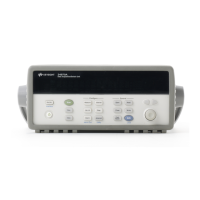Gain Adjustment
The Internal DMM stores a single new gain correction constant each
time this procedure is followed. The gain constant is computed from
the calibration value entered for the calibration command and from
measurements made automatically during the adjustment procedure.
Most measuring functions and ranges have gain adjustment
procedures. Only the 100 M
Ω range does not have gain calibration
procedures. The gain calibration value may be entered through the
front panel menu or over the remote interface. See page 53, for an
example of how to enter calibration values.
Adjustments for each function should be performed ONLY in the
order shown in the performance verification table. See “Performance
Verification Tests” earlier in this chapter for the tables used for gain
adjustments.
Gain Adjustment Considerations
• The zero adjustment procedure must have been recently performed
prior to beginning any gain adjustment procedures.
• The optional –10 Vdc adjustment should be performed only after
servicing the Internal DMM’s a-to-d converter or after replacing
network A4
U101 or calibration RAM A4U505.
• When performing a 4-wire ohms gain adjustment, a new gain
correction constant is also stored for the corresponding 2-wire
ohms measurement range. If desired, the 2-wire gain can be
adjusted separately after the 4-wire ohms gain calibration is
completed.
• During the ac voltage gain adjustments, some of the dc voltage
gain constants are used. Perform the dc voltage gain calibration
before the ac voltage gain calibration.
Note: Never turn off the instrument during a Gain Adjustment.
This may cause calibration memory for the present function to be lost.
Chapter 4 Calibration Procedures
Internal DMM Adjustments
82

